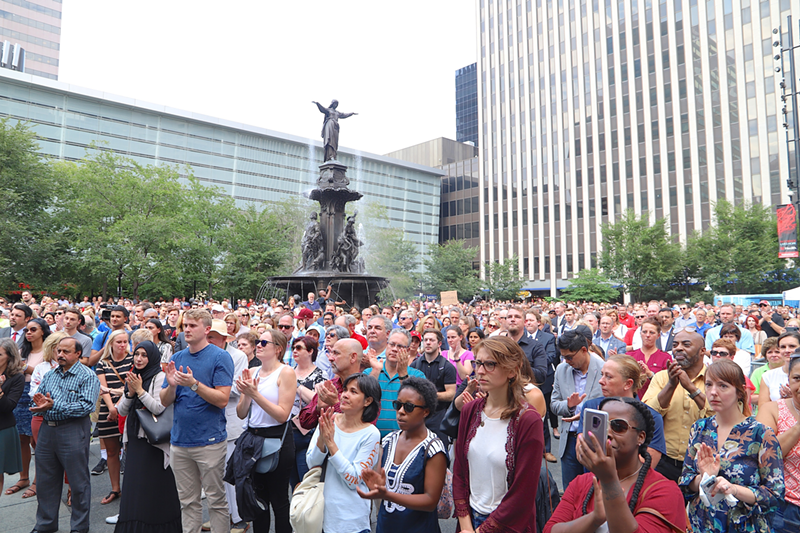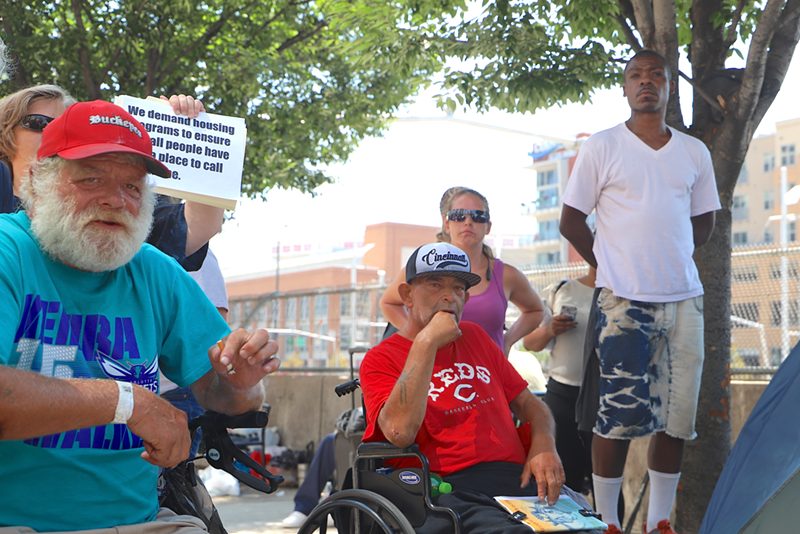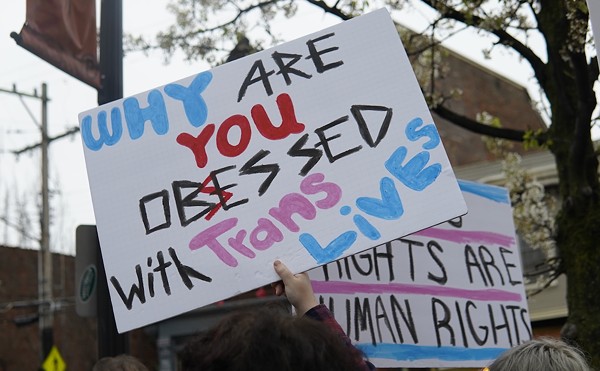Maybe you could say this about any given year, but 2018 in Cincinnati felt overloaded, sagging under the weight of a number of heavy local stories.
There was the near-meltdown within City Hall as City Manager Harry Black faced off with Mayor John Cranley before eventually exiting just before getting fired by Cincinnati City Council.
There was the tragic death of 16-year-old Kyle Plush, who suffocated in his van after calling 911 twice, and the resultant fallout around the city’s Emergency Call Center.
There was the horrific mass shooting at Fountain Square, which killed three people and injured two others.
Those were finite incidents, but larger questions also loomed around the city’s affordable housing supply (it’s about 30,000 units short, data suggests), police use of tasers against young people and the way the city responds to increasing homelessness.
There was jubilation as well, of course, most significantly around FC Cincinnati’s acceptance into Major League Soccer and the coming construction of a $250 million stadium the team will undertake.
But that, too, comes with trepidation around the impact it will have on the historic West End, long the heart of Cincinnati’s African-American community.
There were plenty more stories, which you can find by perusing CityBeat's news archive. Consider this an extended ICYMI highlighting the Cincinnati stories that dominated 2018. May 2019 be just as interesting, but also happier.
FC Cincinnati Moves Into the Big Leagues
After months of waiting, political wrangling, angst over the location of a stadium that wasn’t for sure going to happen and a few false starts, the news came officially on May 29, when Major League Soccer Commissioner Don Garber stood with FC Cincinnati leadership and Mayor John Cranley in the cavernous Over-the-Rhine taproom of Rhinegeist, officially welcoming the team into the league. FCC beat out larger cities for the distinction, in large part due to its rabid fan base (and their record-breaking appetite for tickets).
The fevered, overjoyed atmosphere in Rhinegeist that day belied the long, hard process that led up to that moment, including a tumultuous debate about where the team’s stadium should go. Would it be Oakley? The West End? Would FC Cincinnati betray its name and go to a location in Newport?
In the end, however, the team, in line with preferences of the league, chose a spot near the urban core — just a block from bustling OTR and right where Cincinnati Public Schools’ Stargel Stadium resided.
On the day FCC’s major league hopes were confirmed, Garber revealed that FC Cincinnati’s chosen location for their coming stadium in the West End was the league’s favorite site.
“Many years from now, after your club has been launched and playing many years, after many thrills and victories and agonies and defeats, you’re going to remember this day as a truly historic event for the Queen City,” he said. “You should be incredibly proud of your meteoric rise as one of our continent’s major soccer cities.”
There were plenty of complications along the way, of course: negotiations with CPS. Negotiations with Cincinnati City Council. A decisive “no” vote from the West End’s Community Council, followed by efforts from the council’s executive board to put a deal back together, leading to the eventual signing of a community benefits agreement between the team and a few neighborhood representatives.
Eventually, the big questions were settled. The City of Cincinnati will spend $34 million on infrastructure around the stadium. Hamilton County will chip in another $15-$22 million on parking. The Port of Greater Cincinnati Development Authority will issue bonds, paid by the team, for the $250 million stadium project. The Port will also work with West End nonprofit Seven Hills Neighborhood Houses to try and ensure development around the stadium is equitable in the predominantly black West End.
Even now, after a Dec. 18 groundbreaking event that drew hundreds, there are still loose ends: property to be acquired, businesses and at least one resident who once occupied the footprint of the coming stadium to be relocated.
The stadium’s long-term impact has yet to reveal itself, but as hundreds of shovels dug into the ground during the groundbreaking ceremony, this much was clear: Major League Soccer is coming to Cincinnati, and in 2021, a brand-new soccer facility will stand in one of the city’s oldest neighborhoods.

Tragedy at Fountain Square
The shootings inside Fifth Third Bank’s downtown headquarters just off the public plaza at the city’s heart unfolded in a few quick, confusing moments on Sept. 6, but they left an indelible mark on Cincinnati.
Before police shot through plate glass windows and killed him, Omar Enrique Santa Perez ended three peoples’ lives and injured two with a legally-obtained 9 mm pistol. It was the deadliest mass shooting in Cincinnati in five years.
Santa Perez, 29, entered the towering office building via a loading dock and began firing shortly after 9 a.m. He then made his way to the lobby of the building, firing numerous times seemingly at random.
Richard Newcomer, a 64-year-old construction superintendent for Gilbane Building Co.; Pruthvi Raj Kandepi, 25, a contractor for Maryland-based TEK Systems; and Luis Felipe Calderón, 48, a finance manager for Fifth Third, were the victims killed in the shooting.
Whitney Austin, a 37-year-old from Louisville, Ky. who works as a vice president for Fifth Third, took 12 bullets in the shooting, but survived, as did the other wounded victim, Brian Sarver, a contractor for CBRE.
Many others narrowly avoided the carnage. Officials would later say Santa Perez was carrying 200 extra rounds in a briefcase.
The Fifth Third shootings marked the 15th mass shooter situation with four or more victims in Greater Cincinnati since 2013.
Those shootings have injured more than 90 people. The violence at Fifth Third was deadlier than 2017’s Cameo Nightclub shooting, which killed two and injured 15.
Nationwide, at the time of the shooting, there had been 242 others that had injured at least four people in 2018, according to the Gun Violence Archive.
Nine of those had been in Ohio, including one earlier in September at a club in Cleveland that killed one and injured seven and another incident in Cincinnati in East Price Hill in May that injured four.
Details would emerge later in the day that gunman Santa Perez may have been suffering from mental illness. In 2017 and again this year, he filed lawsuits in the U.S. District Court for Southern Ohio against CNBC and NBC Universal alleging that the media companies were spying on his personal electronic devices and using them to defame him in broadcasts.
No material involving Santa Perez is evident from either broadcaster, and a judge dismissed both lawsuits with prejudice.
“Plaintiff’s pro se complaint is rambling, difficult to decipher, and borders on the delusional,” U.S. District Court Magistrate Judge Karen L. Litkovitz wrote June 26 this year in recommending the latter suit be dismissed. “Plaintiff’s complaint provides no factual content or context from which the court may infer that the defendants violated plaintiff’s rights.”
Santa Perez had lived in Cincinnati since about 2015. Before that, he had lived in Greenville, S.C., where he was the subject of a trespassing complaint after refusing to leave the premises of a former employer, local media there reports. He also lived in Florida prior to his time in Cincinnati, where he had minor run-ins with the law.
After the terror, city residents rallied to support victims and attempt to return to normalcy.
The day after the carnage, more than 2,000 Cincinnatians gathered for an afternoon vigil on Fountain Square to remember its victims.
“We are Cincinnati strong today because we stand on the shoulders of everyday people who build this city, who go to work, who do their jobs,” Mayor John Cranley said at the event. “Whether they’re like Luis Calderón from Florida, trying to make a better living for family, or someone from India here to live the American dream, or Richard, who built the buildings that we work in, let’s give them applause for who they are and what they do.”
Battle Over Tent Cities Underscores City’s Affordable Housing Gap
Cincinnati officials’ efforts to remove a tent city under Fort Washington Way in July escalated into a drawn-out game of cat and mouse between city and Hamilton County officials and residents of various camps that popped up in Pendleton and Over-the-Rhine.
The fight spawned a legal battle that looks likely to extend itself into 2019. And the city’s ongoing struggles with homelessness look likely to continue even longer, given Cincinnati’s 30,000-unit gap in affordable housing.
In the midst of the fight this summer, Hamilton County Common Pleas Judge Robert Ruehlman issued a restraining order at the request of the city and Hamilton County Prosecutor Joe Deters that made it illegal to camp outside in the neighborhoods where the tent cities were popping up (later it was extended to include all of Hamilton County).
Officials representing the city and Hamilton County argue that tent cities like the ones that sprang up this summer present a public health hazard, and that they attract drug use and violent crime. Officials also argue that because there was room in shelters for those living in the camps, using threat of arrest to clear the tent cities is acceptable and legal.
Advocates, however, have pushed back at that claim and tie the prevalence of the camps to lack of access to affordable housing, mental health treatment, good-paying jobs and other necessities. They have also challenged the assertions that there is enough capacity in shelters for everyone experiencing homelessness, presenting data in their latest court filing they say contradicts that claim.
Nonprofit Strategies to End Homelessness, which coordinates shelters and programs to move people into permanent housing, counted more than 7,100 Cincinnatians who experienced homelessness at some point last year.
Though shelters in the area had been full or over capacity, they made room to accommodate those in the camps, according to Strategies to End Homelessness CEO Kevin Finn.
The threats of arrest for camp inhabitants in Cincinnati sparked some debate about whether officials here were overstepping their bounds. But the county argued that’s not the case.
“Because the encampment moved onto private property, a premises which is completely lacking the public health and safety requirements that are required by Ohio law, this court’s injunctive powers to prevent the nuisance caused by the encampments are still applicable,” the city and county’s request for Ruehlman’s injunction reads.
Some residents of the Cincinnati camps found housing, but many remain homeless. In the weeks after the camp was cleared, some residents who were unable to find housing received citations from police for sleeping outside.
Advocates like the Homeless Coalition say shelter capacity shouldn’t matter. But they also take issue with the assertion that there is enough shelter space in the region, and in the latest court filing, the group shares data from the Department of Housing and Urban Development about calls to a Hamilton County hotline for emergency shelter access.
An average day in August — the last month of the tent city standoff — saw calls looking for space in family shelters for roughly 94 people, the filing says. Ninety-five percent of those people were turned away due to lack of space.
Those calling the hotline looking for space in shelters for individuals fared somewhat better, the filing shows — but 73 percent were turned away due to lack of space.
The filing presents similar data showing individuals and families were turned away from shelters due to lack of space in other recent months.
Advocates have also extended the debate beyond criminalizing homelessness, pointing to the region’s housing gap as a root cause of the problem.
The amended filing also notes that Hamilton County needs tens of thousands of units of affordable housing to meet demand from those making under $14,000 a year, according to a study by the Greater Cincinnati Local Initiatives Support Corporation.
City Hall Unsettled
Just before a rare Saturday morning meeting of Cincinnati City Council on April 21, then-Cincinnati City Manager Harry Black resigned as council prepared to take a vote to fire him, ending an unprecedented and bizarre standoff in City Hall.
Though the city has in some ways moved on — Cincinnati has a new city manager, Patrick Duhaney, for example — the incident continues to reverberate throughout city government.
Black, who has been locked in a bitter battle with Mayor John Cranley since the mayor asked him to resign March 9, released a brief memo outlining his resignation moments before the vote to oust him. That memo ended by leaving open the possibility of legal action by Black.
“It has been my pleasure serving as city manager,” Black wrote, praising the city’s “many amenities” and public workforce. “I have made this decision based on the reality that the work environment has become very hostile, and as such untenable. Therefore, it is in my best interest to extricate myself, in that this hostility is unlikely to cease. In resigning, I am not surrendering any of my legal rights.”
Black had protested his treatment at the hands of Cranley, and his supporters on council and among African-American groups like the local NAACP said he was being forced out for firing Cincinnati Police Chief Dave Bailey, whom CPD Chief Eliot Isaac accused of insubordination.
That situation — its own convoluted intrigue around overtime pay to certain high-ranking CPD officials and accusations by Bailey that there was misconduct involved — also continues to wind its way through the courts.
Prior to Cranley’s request that Black resign, the city manager said a small “rogue element” within CPD was working to undermine the chief and the city’s Collaborative Agreement police reforms.
Cranley, however, says that his request that Black resign came after years of complaints about intimidation and retaliation against city employees by the city manager.
The disagreement led to a big fight between council and the mayor over whether Black should leave and how much he should receive if he did. Initially, Black would have gotten nothing if he resigned.
The agreement he ended up accepting awards Black the standard severance package he would have gotten if he had been fired.
Per Black’s contract, he will get eight month’s salary and benefits — a severance package worth about $274,000.
The mood this spring was tense, to put it lightly.
“This is the worst I’ve ever seen,” Cincinnati City Councilman David Mann, who has served a cumulative 23 years in City Hall, told CityBeat at the time. Other long-term Cincinnati politics watchers agreed: City government reached an unprecedented stalemate.
But how did we get there? Various players in the drama, as well as outside observers, had different explanations for the mess.
Some pinned it on the city’s charter. They say we need to change Cincinnati’s system of government, which has since 1999 run under a modified city council/city manager structure that some say effectively creates two chief executives for the city.
Others like Mann say the trouble was relational, not structural, and has to do with the mayor and city manager’s strong personalities. Until one of them left, it was impossible to go back to business as usual.
Still others, however, say that racial tensions within the Cincinnati Police Department sparked the tumult, and that CPD is where structural changes are needed.
Whatever the cause, the fallout is still falling, with investigations into the group texting between five Democratic council members opposed to Black’s ouster and continued legal drama around supposed improprieties involving police overtime still looming on the horizon.
All that scrutiny could amount to nothing — or this drama could have a second act in 2019.








